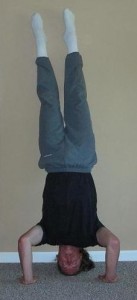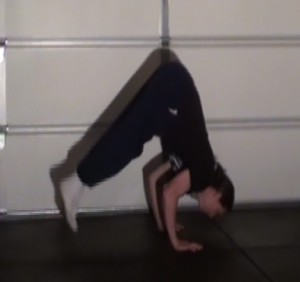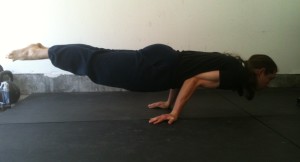You can train every muscle in your body without ever going to a gym or lifting weights, you just have to be creative!
The overhead press is one of the most fundamental strength training techniques out there – and for good reason. Overhead pressing is a great way to build upper-body strength as well as a strong core. Barbells and kettlebells are great for pressing, but no matter how strong you are, handstand push-ups are a unique challenge and must be treated as such. Get ready to flip the classic overhead press on its head – literally!
Pike Press
If you aren’t strong enough to do a handstand push-up yet, the pike press is a great way to ease in. Pike presses allow you to train the movement pattern without having to bear your entire body weight.

Rest your toes on a bench or step and get down in a push-up position. From here, walk your hands back toward the bench while you pike your hips up in the air over your shoulders. You will wind up looking like an upside-down letter L, with your body bent in half from the waist. Try to keep your back straight by taking the stretch in your hamstrings. You can bend your knees a little if you need to in order to keep your hips up over your shoulders. Lower yourself down until the top of your head touches the ground and then push yourself back up – that’s one rep.
Wall Assisted Handstand Push-up
Once you can do ten consecutive pike presses without too much trouble, you’re ready to try a full handstand push-up against a wall. Kick up into a handstand with your back slightly arched and your fingers spread out. Engage your core muscles and keep your body tight as you lower yourself down and press yourself up. Make sure you touch your head to the ground on every rep to ensure a full range of motion. You can also try touching your nose to the floor instead of the top of your head to allow yourself to go a bit lower.
Handstand Push-ups on Parallettes
If you want a bigger range of motion for your handstand press, you’ve got a couple options. You could use a set of parallettes or you could set up two benches (or other sturdy objects) alongside each other with enough room for your head to fit in between. Any method that allows you to drop your head below your hands will add a new challenge to your handstand push-ups.

Freestanding Handstand Push-up
The freestanding handstand is a tricky move to get the hang of on its own, adding a push-up to it takes things to a whole other level!
The freestanding handstand push-up requires tremendous strength, balance and total body control, so before you think about training for this move, I suggest getting to the point where you can do at least ten wall assisted handstand push-ups and hold a freestanding handstand for a minimum of thirty seconds.
When performing handstand holds, I’ve often found it helpful to look in between my hands. With the freestanding handstand push-up however, I’ve found it better to look a few inches in front of my hands. Since the balance changes throughout the range of motion, I recommend practicing static holds at the bottom and middle positions of the range of motion to help train for this feat.
The One Arm Handstand Push-up
Often discussed, though never actually executed, the one arm handstand push-up is the holy grail of bodyweight strength training. In theory, the one arm handstand push-up is the ultimate calisthenics exercise. However, a full, clean rep has never been documented as far as I know. I have no doubt that someone will eventually perform one (and get it on video), but in the meantime the rest of us will just continue to train hard and keep the dream alive.

Watch the video below for more:
For more from Al Kavadlo check out his website here. He is the author of several books Pushing the Limits!, Raising the Bar and his newest book Stretching Your Boundaries, as well as the head instructor of the Progressive Calisthenics Certification.









